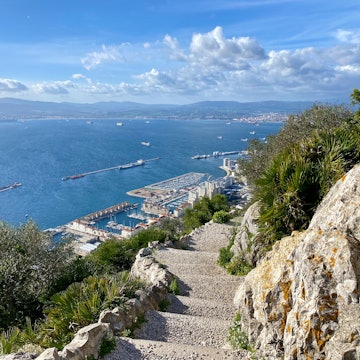
How to get your cell phone connected in Spain: eSIMs, wi-fi and mobile networks

Jun 24, 2025 • 5 min read

Stay connected when on vacation in Spain with this guide to cell service, roaming charges and data. Iuliia Khabibullina/Shutterstock
Sagrada Família, Parque del Retiro, the Alhambra – these are just a few of Spain’s top travel icons and a big reason for making it the second most-visited country in the world. But what’s the best way to navigate these places once on the ground? And how can visitors stay connected when traveling to this beloved country?
To help you make the most informed decision about international phone service, connectivity speeds, and data use, here’s what you need to know before booking your next trip to Spain.
Will my phone work in Spain?
If you pay for service from a major US cell carrier, there’s a high chance your phone will work in Spain. But there’s an even higher chance you’ll pay for costly roaming charges – as high as $1.50 extra per minute, $0.50 extra per SMS, and $5–10 extra per MB of data, according to Network World.
To put that in context, 1 gigabyte (GB) of data equals 20–30 minutes of web browsing and/or checking emails, or about an hour of streaming video. In other words, not only are roaming charges expensive, they add up incredibly fast with how frequently we use our phones today.
EU citizens don’t incur roaming charges if traveling within the EU.

What mobile networks are available in Spain?
Spain has four primary mobile providers: Movistar, Vodafone, Orange, and Yoigo. Movistar has the best coverage throughout the country (and generally higher prices), followed by Vodafone and Orange, although differences between these provided are minimal.
In terms of coverage, Spain is ranks first in 5G readiness for mobile data speeds, averaging up to 50 Mbps and as high as 250 Mbps. Additionally, over 92% of households have 5G coverage (including both Balearics and the Canary Islands), according to Euro News. In other words, you’ll incur little to no slowdown while visiting.
How can I get a local SIM card?
Like the majority of Europe, local prepaid SIM cards can be easily purchased at one of many airport kiosks or convenient stores in town. Options range between $10–40 per bundle, depending on the amount of data purchased. To buy a local card, you’ll usually need a valid passport, credit card, and/or local currency if paying with cash. Before leaving the store, remember to confirm that service is working and what phone number you were given.

Is eSIM available in Spain and how does it work?
Non-physical eSIM cards are readily available in Spain and offered from over a dozen local carriers that operate on major carrier networks. These easy-to-use electronic or digital SIM cards work with all modern smartphones, bypass the need to acquire a local SIM card, and are increasingly becoming the most popular way to stay connected when traveling abroad. On average, prices range between $1–4 per GB and can be used for as little as 4–7 days. Better yet, most providers let you order plans in advance online – no physical store required.
We recommend Saily, our eSIM partner, for your next trip to Spain. Plans start at $3.79 for 1GB of data. Use code LP5 to receive a 5% discount on your Saily data plan. Download the Saily app to
set up your eSIM, and your plan will be activated automatically.
Where can I find reliable wi-fi in Spain?
As with most parts of the world, you can find free wi-fi at major Spanish airports, cafes, some attractions, and most hotels. While you won’t be able to “carry” this service with you when roaming about, it can help fill in the coverage gaps and save data use when using any local mobile providers.
Just be sure to understand the security concerns of public wi-fi, and only use general, non-password protected websites. While public wi-fi is appropriate for general browsing, security experts recommend avoiding it for checking email, bank accounts, and other sensitive records online, as cybercriminals can mine personal data over public networks.
Are there any internet restrictions or censorship laws?
The Spanish constitution enshrines freedom of speech and the press, and there are no government restrictions or censorship in Spain when accessing the internet. In Spain it is legal to use a VPN, which is a common way to protect your data and online privacy.

Can I stay connected at major tourist sites?
Public wi-fi is often available at popular tourist sites, but reliability can vary. As a general rule, however, the more rural you go, the less likely you’ll encounter free, public wi-fi. To ensure you stay connected, a fair priced international plan, eSIM, or local SIM service is recommended.
That said, both Barcelona and Madrid offer free, city-wide wi-fi for everyone – foreign visitors very much included. So if you’re only visiting those two cities, you might be able to get by without a local phone provider.
Will I encounter language barriers when getting connected?
Local providers, especially at airport kiosks, are fluent in English and can easily help travelers set up a phone plan. The same is true of convenience stores in town, although English availability will understandably vary (the smaller the town, the fewer English speakers you’ll find). In general, you will have little to no issue getting customer support in English at cell phone stores when visiting Spain.
What local customs or etiquette should I be aware of?
Like much of Europe, Spain uses the “two prong” type F outlet plugs and 230 volts, so don’t forget to bring the proper adaptor. For locals it’s considered rude not to answer your phone, so it’s perfectly normal and acceptable to answer calls and carry on conversations on public transport, in restaurants, and even during business meetings.
How do I contact emergency services if needed?
In Spain, dial 112 to quickly connect with emergency services. And as a backup, be sure to download offline map access to specific locations you’re visiting, whether on Google or Apple Maps.
This article was produced by Lonely Planet as part of our partnership with Saily, a global eSIM service. Lonely Planet's advice and opinions are solely our own.















